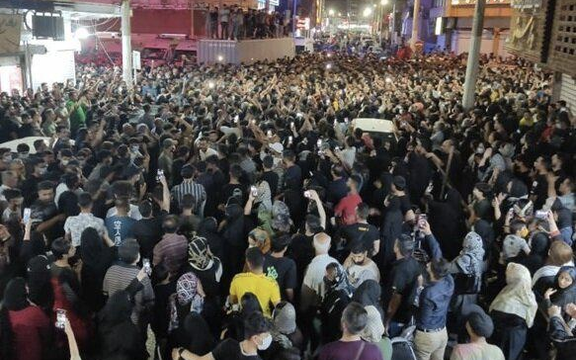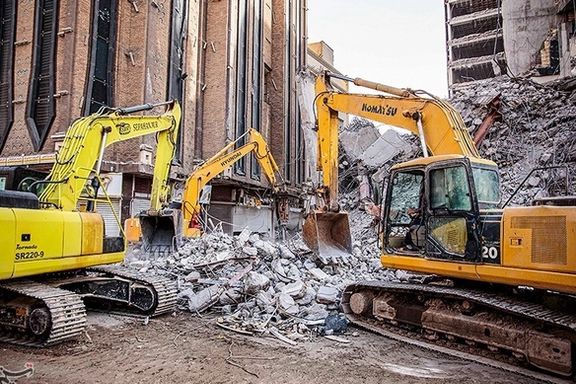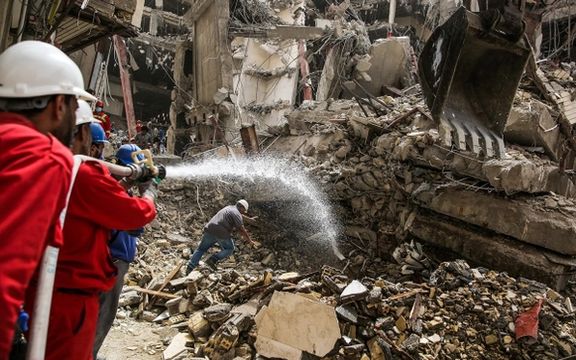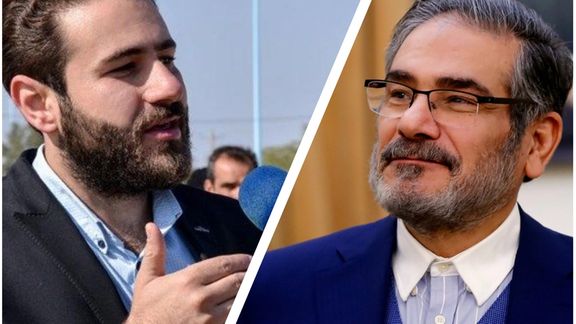People In Tehran Stadium Chant Slogans In Support Of Abadan Protests

People who gathered at Tehran’s Azadi stadium to celebrate the championship of Esteghlal football club on Monday chanted slogans in support of Abadan protests.

People who gathered at Tehran’s Azadi stadium to celebrate the championship of Esteghlal football club on Monday chanted slogans in support of Abadan protests.
The Monday match between Esteghlal and Naft Masjed Soleyman FC ended in a goalless draw, but it was more than enough for Tehran’s Blues to clinch the championship of the current season of Iran’s Premier League.
During the match as well as during the celebrations after the match, spectators were heard chanting slogans in solidarity with the people of Abadan, who have been holding protests since last Monday following the collapse of a 10-story building that left 33 people dead and about 30 missing. It quickly became apparent that the owner and builder was a well-connected businessman who had disregarded regulations and building codes, being backed by officials, who might have had their own financial interests.
Videos surfaced on social media on Monday showing a large group of people from Khorramshahr, another city in Iran’s oil-rich Khuzestan province, marching towards Abadan to support the popular protests there.
In previous days, there were protests in several cities in Khuzestan, such as Andimeshk and Masjed Soleiman, where people gathered to voice their support for protesters in Abadan, where grief for the victims and anti-government outrage have fused into a potent anger.
Amid the tense situation in the city Sunday night, Arab tribal groups began streaming into Abadan and warned the security forces that if they shot the people, tribes would resort to weapons to defend them.

Some Iranian unions and civic groups have expressed solidarity with popular protests centered in the south-west, urging security forces to exercise restraint.
In a statement released on Monday, the Workers Syndicate of Tehran and Suburbs Bus Company said the voice of the people who are suffering from corruption in the government cannot be silenced by deception and crackdown.
They said the culprits of the disaster are the authorities who turned a blind eye to corruption and permitted the construction of the building by unreliable people who took advantage of nepotism and connections with government officials.
The statement goes on to say that authprities with all their means and tools of repression are trying to silence the voices of the families of the victims and the and the demands of the people in Abadan and other cities in Khuzestan and elsewhere in the country, and “as usual, they respond to any protest with bullets, batons and tear gas.”
Anti-government protests have been taking place since last week in several cities across Iran’s oil-rich Khuzestan province as well as in other cities in support of the people of Abadan with security forces firing tear gas and shots to disperse the crowds.
Protests began last week, when on Monday a 10-story building collapsed in Abadan, leaving 32 people dead and an equal number missing. The people of Shahinshahr in the central Esfahan province and Bandar Abbas in the southern province of Hormozgan also held protest rallies to show their solidarity with the people of Abadan, whose mourning ceremonies for the victims of the Metropol twin towers have turned into anti-government protests since Wednesday.
It quickly became apparent that the owner and builder was a powerful and well-connected businessman who had disregarded regulations and building codes, backed by officials, who might have had their own financial interests.
The Iranian Writers Association also issued a statement saying the state media tried to hide facts and information about the tragedy by describing the building as not complete and publishing false figures on injured and missing persons.
They condemned the government’s “clumsy show aimed at covering up corruption institutionalized in state agencies and institutions,” saying the authorities’ first reaction to the tragedy was not sending relief crews, but dispatching anti-riot forces, cutting off Internet access, and misinformation.
The association also said the ongoing clampdown on the protesters is reminiscent of the November 2019 protests, the bloodiest in Iran’s history with security forces opening fire on demonstrators in many cities, killing hundreds. Thousand were arrested and jailed without due process of law and there were numerous reports of torture in prison.
In another statement published on Sunday, headlined, "Put Down Your Gun,” a group of filmmakers and actors called on security forces responsible for suppressing the popular protests to lay down their weapons.
Now, that public outrage over corruption, theft, inefficiency, repression and suffocation has created a wave of popular protests, "we call on all those who have become agents of repression in the military units to lay down their weapons and return to the embrace of the nation."

Large anti-government protests again rocked Iran’s oil-rich Khuzestan province Sunday night as security forces fired tear gas and shots to disperse the crowds.
Protests began last week, when on Monday a 10-story building collapsed in Abadan, leaving 31 people dead and an equal number missing. It quickly became apparent that the owner and builder was a powerful and well-connected businessman who had disregarded regulations and building codes, being backed by officials, who might have had their own financial interests.
As the government dispatched more anti-riot special forces to Khuzestan, south-western Iran, the atmosphere Sunday night in the city of Abadan was tense. A large crowd seemed ready to confront government forces. First, the anti-riot troops started using tear gas and guns. Shots were fired as some vodeos showed security forces poitning their guns at protesters and shooting.
News from Abadan, which is home to the Middle East’s oldest oil refinery, is sketchy because the government blocked mobile internet access to prevent news and videos from leaking out. If large protests spread to other cities and provinces, it could pose a serious danger to the Islamic Republic’s rulers.
But one incident in Abadan was clear. The most senior cleric appointed by Supreme Leader Ali khameni tried to speak to the crowd but was booed, pelted and shouted down. He had to leave the scene.
Amid the tense situation in the city Sunday night, Arab tribal groups began streaming into Abadan with their banners and warned the security forces that if they shot the people, tribes would resort to weapons to defend them. Khuzestan is home to Iran’s Arab population, which live side by side with Persians and other ethnic groups. The province is the oil industry center of the country, where people from different parts of the country find jobs.
Some videos showed that at one point security forces pulled back after the warning from the tribes and crowds were marching in main streets without being attacked.
Iran International received reports of large-scale arrests in Khuzestan on Saturday, as the government tried to round-up potential protest leaders and activists.
In Masjed Soleiman, another oil industry city, people gathered to voice their support for protesters in Abadan, where grief for the victims of the building collapse and anti-government outrage have fused into a potent anger. People in Andimeshk, another Khuzestan city also marched in protest.
In previous days, there were protests also in several other cities in Khuzestan but the whole picture from Sunday night is still unclear and it is hard to say what transpired elsewhere in the province.
Security forces were also on alert outside Khuzestan, with heavy presence and patrols in Shahin Shahr, near the historic city of Esfahan in central Iran. As residents tried to gather to express solidarity with Abadan, security forces intervened to stop the gathering. Again, details are sketchy.
On Sunday, before the start of night-time protests, around one hundred film industry figures issued a statement calling on security forces to lay down their weapons and not fire at protesters. The phrase, “Lay down the gun,” from the statement quickly spread on social media.
There were unconfirmed reports on Twitter that the government began rotating some security forces, allegedly to make sure that units more willing to confront protesters would be deployed in sensitive spots.

Sporadic protests continued in Iran on Saturday despite a heavy presence of security forces and minimal information available with lack of internet access.
The main hotspots were in the south-western Khuzestan province, center of Iran’s oil industry, where protests erupted on Tuesday after the collapse of a 10-story building killing at least 29 people. More than thirty dead victims are still in the rubble of the building.
Thousands of security forces, some dispatched to Khuzestan in recent days, were present in Abadan where the building incident took place and in other cities. Nevertheless, reports said protests took place in Andimeshk, while in Abadan, nearby port of Khorramshahr and the provincial capital Ahvaz security forces tried to prevent large gatherings. In fact, activists said that the situation in these cities resembled marshal law.
There were also protests in a suburb of Tehran Saturday evening. In Shahre-Ray protesters gathered and chanted "Death to the dictator" in a popularized slogan directed at Supreme Leader Ali Khamenei.
Authorities also began a determined effort to arrest as many suspected protesters and protest organizers as possible on Saturday, but there is no clear information about the extent of these arrests. Usually, it takes a few days until news trickles out amid the internet disruption and the prevailing atmosphere of fear and police crackdowns.

The building collapsed that triggered the current protests has become a symbol of government corruption for Iranian, as it became clear that there were multiple violations involved, including the owner adding five floors despite strong objections by engineering inspectors. The mayor’s office in Abadan appears to have been complicit in approving or ignoring the violations.
From the very day of the incident on May 23, authorities began to realize the collapse of Metropol building would have political ramifications and began arresting some local officials. Initially they said that the owner was also detained, but a day later, on May 24 officials changed their story, saying he died under the rubble.
Many people and journalists on social media expressed deep skepticism, putting forward a different scenario that the well-connected businessman simply escaped and his friends in the government were attempting to cover up by claiming that he died in the collapse.
Iran International published two documents Friday that suggested a connection between the owner of the building Hossein Abdolbaghi and Mowud Shamkhani, son of the secretary of the Supreme National Security Council, Ali Shamkhani, and other influential local officials who may have used their influence to help Abdolbaghi participate in large municipality-funded projects.
On Sunday, an Iranian official in Khuzestan revealed that a government-run free trade zone had ceded three parcels of land to Abdolbaghi, but the decision has now been rescinded. The powerful Shamkhani clan was previously running the free economic zone and the issue of land for Abdolbaghi shows there is perhaps more to hidden connections between political and business magnets, who use their combined means to engage in illegal deals.

Fars news agency has acknowledged that Iranian security forces used tear gas and fired in the air to disperse protesters in Abadan, Khuzestan, Friday evening.
In its report, Fars, affiliated with the Revolutionary Guard (IRGC) claimed that police forces had to use tear gas and fire in the air because protesters insisted on entering the area where one side of Metropol twin towers, a newly built ten story building, collapsed on Monday. So far 28 bodies have been pulled from the ruins of the building and there may be tens more still buried under the rubble.
Reports by Iranians on social media said IRGC security forces fires on the people, but no casualty figures have been mentioned.
Not mentioning any of the slogans against Supreme Leader Ali Khamenei and other authorities, Fars fundamentally downplayed the size of protests in other cities. “In Ahvaz 200 people lit candles in front of the Central Library,” the Fars report said.
Videos and posts on social media, however, tell a completely different story. “We Are People of the War, Let Us Fight,” one of the videos shows a large crowd of protesters chanting in Ahvaz, capital of oil-rich Khuzestan province, in reference to their history of fighting against Saddam Hossein’s forces during the eight-year war with Iraq (1980-1988).
Gunshots are heard in other videos from Ahvaz Friday evening and people fleeing from security forces on foot and on motorbikes. Social media users also said it was the IRGC, its Basij militia, and the anti-riot guards who shot at people, not the police, as Fars claimed. They have also reported continued disruption in internet access.

Thousands took to the streets to protest against the government and express solidarity with the people of Abadan in several cities Friday evening, including Shahin Shahr, a city in the central Esfahan Province where many Khuzestani refugees of the Iran-Iraq war (1980-1988) still live, Behbahan in Khuzestan, and the port city of Mahshahr in Hormozgan Province.
Protesters in the past few days have been chanting slogans against the Islamic Republic, particularly Supreme Leader Ali Khamenei who they blame for mismanagement of the country and corruption which allows well-connected individuals such as Hossein Abdolbaghi, the owner of Metropol twin towers, to bypass regulations and put people’s lives in danger. Authorities say the building collapsed because using his connections with influential officials, the owner had added five more stories to the original plan.
Referring to Supreme Leader Ali Khamenei’s demand to pursue the culprits and to impose “exemplary punishment” on them, pro-government and state-funded newspapers such as Khorasan and Jam-e Jam have urged punishment to prevent corruption and further tragedies.
Iran has a long record of executing “disruptors of economy” and corrupt individuals but in a report Friday entitled “The Execution That Didn’t Teach a Lesson”, the semi-official Mehr news agency asked why such measures, including the execution of businessman Mahafarid Khosravi in 2014 for his part in a massive bank embezzlement scandal in 2011, have not stopped corruption.
Referring to the controversies over the authorities’ claims that the owner of the building was among those who died in the collapse of his building, the reformist Etemad newspaper criticized censorship and “absence of independent and credible media”. “Controversies over whether Abdolbaghi is dead or alive are a direct consequence of untrustworthiness of official media,” Etemad wrote.
Another article in Etemad, entitled “Metropol: The Height of Corruption”, said corruption in the country has taken deep roots because authorities have hugely targeted and restricted non-governmental organizations which could keep watch to prevent corruption and mismanagement of officials.

Taking the cue from the Supreme Leader, most officials are finally calling for punishment of all those responsible for the deadly crash of a building in Iran.
In a message to officials Thursday, Khamenei ordered authorities to pursue the culprits and to impose “exemplary punishment” on them.
But the incident has already led to renewal of anti-government protests this week. Social media users Friday evening reported large protest rallies in Ahvaz, capital of Khuzestan, Shahin Shahr, a city in the central Esfahan Province where many Khuzestani refugees of the Iran-Iraq war (1980-1988) still live, and the port city of Mahshahr in Hormozgan Province. They have also reported continued disruption in access to the internet.
Iran International has acquired two documents that suggest a connection between the owner of the building Hossein Abdolbaghi and Mowud Shamkhani, son of the secretary of the Supreme National Security Council, Ali Shamkhani, and other influential local officials who may have used their influence to help Abdolbaghi participate in large municipality-funded projects.

Chief of the operations on the ground, Ghodratollah Mohammadi, Friday evening said two more bodies had been recovered from the debris bringing the death toll to 26 and warned about the collapse of the second tower of the ten-story Metropol twin towers.
Many in Khuzestan and other areas of the country are also angry that it took Khamenei three days to show any reaction to the tragedy and at the government for not declaring a day or days of public mourning.
Thousands held anti-government protests Thursday in Abadan and some other cities chanting slogans against Khamenei such as “Death to Khamenei”, “Shame on You Khamenei, Leave the Country Alone”, and “Khamenei Is a Murderer, His Rule Is Illegitimate”.
Protesters hold the Supreme Leader responsible for mismanagement of the country and the corruption which allows well-connected individuals such as Abdolbaghi to bypass regulations and put people’s lives in danger.

Vice President Mohammad Mokhber who visited the site Friday morning alleged that there has been “extensive corruption” involving the owner, contractor, and regulatory bodies that issued the construction permits. He has warned that the owner of Metropol twin towers had constructed several more buildings in Abadan and the nearby Khorramshahr port city which should be investigated for other possible regulatory breaches and imminent danger to the public.
The governor of Khuzestan, Sadegh Khalilian, has confirmed that the building was originally planned to have six stories, but five more stories were added in two separate stages, apparently with the approval of municipality authorities, in breach of building codes.
Many high-level officials, including state-appointed Friday imams, are now urging hard punishment for the tragedy. The Imam of Khorramshahr, Mohammad-Javad Adelpour, urged authorities to be accountable to people and demanded the punishment of all those responsible including officials of the municipality and the provincial governor’s office.
Interior Minister Ahmad Vahidi who also visited the site Friday morning, had called the collapse of Metropol building a “massive crime” a day earlier and said the judiciary will investigate it thoroughly.
Chief Justice Gholam-Hossein Mohseni-Ejei on Friday promised investigation and punishment of all culprits “even if they are from the judiciary itself” to prevent such tragedies from happening again.
But promises of investigation and punishment of culprits are far from convincing to many who are highly skeptical of authorities' claim that Abdolbaghi died in the collapse.